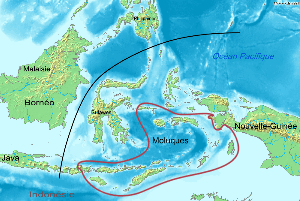Central–Eastern Malayo-Polynesian languages
| Central–Eastern Malayo-Polynesian | |
|---|---|
| Geographic distribution | East Indonesia and Pacific Islands |
| Linguistic classification |
|
| Subdivisions |
|
| Glottolog | cent2237[1] |
|
The Central MP languages (red). (In black is the Wallace Line.) | |
The Central–Eastern Malayo-Polynesian (CEMP) languages form a putative branch of the Nuclear Malayo-Polynesian languages consisting of over 700 languages. The traditional division of CEMP is into Central Malayo-Polynesian and Eastern Malayo-Polynesian. However, Central MP has never been demonstrated to be a valid clade, and Eastern MP is only poorly supported.
The Central languages are spoken in the Lesser Sunda and Maluku Islands of the Banda Sea, in an area corresponding closely to the Indonesian provinces of East Nusa Tenggara and Maluku and the nation of East Timor (excepting the Papuan languages of Timor and nearby islands), but with the Bima language extending to the eastern half of Sumbawa Island in the province of West Nusa Tenggara and the Sula languages of the Sula Archipelago in the southwest corner of the province of North Maluku. The principal islands in this region are Sumbawa, Sumba, Flores, Timor, Buru, and Seram. The numerically most important languages are Nggahi Mbojo (Bimanese), Manggarai of western Flores, Uab Meto of West Timor, and Tetum, the national language of East Timor.
The Central languages may form a linkage. They are for the most part poorly attested, but they do not appear to constitute a coherent group. Many of the proposed defining features of CMP are not found in the geographic extremes of the area. Therefore some linguists consider it a linkage; a conservative classification might consider CMP to be a convenient term for those Central–Eastern languages which are not Eastern Malayo-Polynesian (Grimes 1991). Languages in the east of Flores and nearby islands, such as Savu, have especially large amounts of apparently non-Austronesian basic vocabulary (Würm 1975), but all of the CMP languages appear to have a non-Austronesian substrate that sets them apart.
The Eastern Malayo-Polynesian languages extend from the coasts of Halmahera across the Pacific. They are similarly dubious as a group: per Malcolm Ross, there is "essentially no evidence" that the two branches, Halmahera–Cenderawasih (South Halmahera – West New Guinea) and Oceanic, form an exclusive clade within Malayo-Polynesian.[2] However, the two individual branches are well defined and accepted.
Languages
Given the poor support for larger groupings, some of the groups listed here are provisional.
- Central Malayo-Polynesian languages.
- Sumba–Flores languages, spoken on and around the islands of Sumbawa (eastern), Sumba, and western–central Flores in the Lesser Sundas.
- Flores–Lembata languages, spoken in the Lesser Sundas, on eastern Flores and small islands immediately east of Flores.
- Selaru languages, spoken in the Tanimbar Islands of Indonesia.
- Kei–Tanimbar languages, spoken in the Kei and Tanimbar Islands of the southern Malukus, and on the north side of the Bomberai Peninsula.
- Aru languages, spoken on the Aru Islands in Indonesia.
- Central Maluku languages, spoken principally on the Seram, Buru, Ambon, Kei, and the Sula Islands.
- Timoric, or Timor–Babar, languages, spoken on the islands of Timor, neighboring Wetar, and (depending on the classification) the Babar Islands to the east.
- Kowiai language, spoken on the Bomberai Peninsula in New Guinea.
- Teor-Kur language, spoken near Kei Island, Indonesia.
- Eastern Malayo-Polynesian languages.
- Halmahera–Cenderawasih languages, found in the islands and along the shores of the Halmahera Sea in the Indonesian province of North Maluku and of Cenderawasih Bay in the provinces of Papua and West Papua.
- Oceanic languages, spoken in Polynesia, as well as much of Melanesia and Micronesia.
Notes
- ↑ Hammarström, Harald; Forkel, Robert; Haspelmath, Martin; Bank, Sebastian, eds. (2016). "Central–Eastern Malayo-Polynesian". Glottolog 2.7. Jena: Max Planck Institute for the Science of Human History.
- ↑ Fay Wouk and Malcolm Ross (ed.), The history and typology of western Austronesian voice systems. Australian National University, 2002.
References
- Fay Wouk and Malcolm Ross (ed.), The history and typology of western Austronesian voice systems. Australian National University, 2002.
- K. Alexander Adelaar and Nikolaus Himmelmann, The Austronesian languages of Asia and Madagascar. Routledge, 2005.
